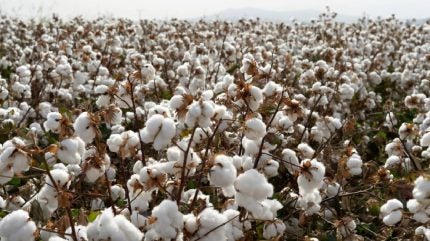
Measuring performance against a 2015 baseline across six sustainability metrics, the report finds that US Cotton Trust Protocol growers met or exceeded five out of six national continuous improvement goals set for 2025.
The achievement marks advancements with implications for both cotton producers and the global supply chain.

Discover B2B Marketing That Performs
Combine business intelligence and editorial excellence to reach engaged professionals across 36 leading media platforms.
The data is intended to assist brands and retailers seeking reliable information for responsible sourcing initiatives.
US Cotton Trust Protocol progress against sustainability goals
- Grower members reduced land use by 15% per pound of cotton produced, reaching this target one year ahead of schedule. On average, these growers produced 20% more cotton per acre than the US national average
- Water use efficiency improved by 87%, meaning that the same output was achieved using 47% less irrigation water, even during widespread drought conditions. This result surpassed the programme’s 2025 water goal
- Energy use per unit of cotton dropped by 28%, contributing to lower Scope 3 emissions for partners throughout the supply chain
- Soil loss was cut by 89%, with erosion rates falling below USDA thresholds. For soil health, growers improved quality on 71% of managed acres, meeting the programme’s soil health target
- Greenhouse gas emissions decreased by 25%, due in part to optimised nitrogen application and precision irrigation technologies.
US Cotton Trust Protocol president Dr Gary Adams said: “This year’s annual report unequivocally demonstrates that sustainable practices deliver measurable improvements in efficiency, resilience, and environmental outcomes that can directly impact the supply chain.
“This report is a testament to the dedication of our growers, whose commitment has resulted in tangible environmental gains, meeting or exceeding five of the six 2025 goals.”
Key highlights from the 2024/25 annual report
- Traceability: Adoption of the Trust Protocol’s traceability solution increased significantly. Brands tracked 126,000t of fibre via Protocol Consumption Unit (PCCU) uptake, representing a 413% year-on-year increase. This accounted for approximately 690m finished products tracked by 20 brands, offering enhanced visibility into US cotton origins
- Regenerative agriculture: Growers participating in the Trust Protocol continue to implement regenerative agricultural techniques. Around 63% planted cover crops and 57% adopted no-till or conservation tillage methods across their acreage. These approaches are aimed at improving soil health and increasing carbon sequestration within cultivated land
- Grower participation: Enrolment in the programme continued to expand despite challenging farming conditions. Acreage enrolled in the Trust Protocol increased by 18% from the previous year to reach a total of 2.58m acres. Membership also rose by 14%, with 1,512 growers now participating in the initiative
- New regenerative pilot programme: The Trust Protocol launched a pilot programme in 2025 designed to formally recognise and verify regenerative practices among its members. This development introduces a new sourcing option for brands and retailers seeking traceable regenerative US cotton.
US Cotton Trust Protocol executive director Daren Abney said: “With emerging regulations like the EU’s Corporate Sustainability Reporting Directive (CSRD) and growing stakeholder scrutiny, the need for verifiable, robust data has never been more important for brands and retailers. Our programme helps deliver that assurance. The expanded use and scale of our traceability system clearly demonstrate that the supply chain is embracing this new level of transparency.”

US Tariffs are shifting - will you react or anticipate?
Don’t let policy changes catch you off guard. Stay proactive with real-time data and expert analysis.
By GlobalDataIn September this year, US Cotton Trust Protocol launched a trial for its Field Partner Program, which aims to formally recognise and verify regenerative practices among cotton growers and achieve measurable results.





